
The Museum of Zoology and Natural History, best known as La Specola, is an eclectic natural history museum in Florence, central Italy, located next to the Pitti Palace. The name Specola means observatory, a reference to the astronomical observatory founded there in 1790. It now forms part of the Museo di Storia Naturale di Firenze. This museum is part of what are now six different collections at four different sites for the Museo di Storia Naturale di Firenze.

Palazzo Spini Ferroni is a large Gothic palace located along Via de' Tornabuoni at the corner of Piazza Santa Trinita, in central Florence, region of Tuscany, Italy. It stands across from the church of Santa Trinita.

The Torre dei Mannelli is a small tower on the southeast corner of the Ponte Vecchio bridge in Florence, Italy. It is the only survivor of the four towers which once defended each corner of the bridge. In 1565, the Mannelli family refused to have it altered or demolished so that the Vasari Corridor could be built in a straight line. Instead the corridor swerved round it on brackets.
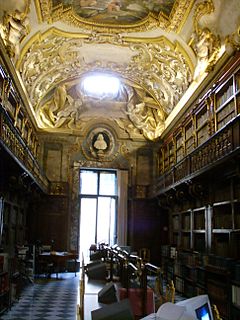
The Biblioteca Riccardiana is a library in Florence, Italy. The library is located in the Palazzo Medici Riccardi.

Via de' Tornabuoni, or Via Tornabuoni, is a street at the center of Florence, Italy, that goes from Antinori square to ponte Santa Trinita, across Santa Trinita square, characterized by the presence of fashion boutiques.
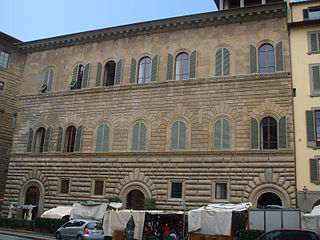
Palazzo Gondi is a palace in Florence, Italy, located a block from Piazza della Signoria. It was built in 1490 under design by Giuliano da Sangallo, who was inspired by other major works of stately buildings in the city, such as Palazzo Medici and Palazzo Strozzi. Among the elements borrowed from these earlier works are the cube-shape set around a central courtyard, the ashlar sloping on each of three floors, and the arched windows.

Palazzo Uguccioni is a Renaissance palace on the Piazza della Signoria in Florence, central Italy.

Palazzo Antinori is a Renaissance palace located at the north end of Via de' Tornabuoni, where it makes an odd corner with Via dei Pecori, Via del Trebbio, and converts into Via dei Rondinelli, in Florence, region of Tuscany, Italy.

The Casino Mediceo di San Marco is a late-Renaissance or Mannerist style palace located on Via Cavour number 57 and via San Gallo in Florence, region of Tuscany, Italy.
The Palazzo di Bianca Cappello, originally belonging to Corbinelli family is a Renaissance-style palace located on Via Maggio #26 of the quarter of Oltrarno in Florence, region of Tuscany, Italy. It is notable for its facade decoration, and once housing Bianca Cappello, the mistress, then wife of the Grand-Duke Francesco I de' Medici

The Palazzo Nonfinito is a Mannerist-style palace located on Via del Proconsolo #12, in central Florence, region of Tuscany, Italy. Begun in 1593 using designs by the architect Bernardo Buontalenti, only the first floor was completed, and additional construction was added later by different architects. The Palace is presently the home of the Anthropology and Ethnology section of the Museum of Natural History of Florence.
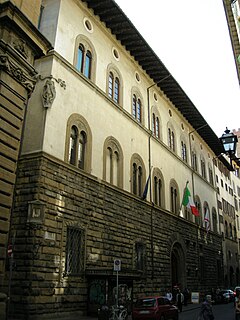
The Palazzo Pazzi, also known as the Palazzo della Congiura or Palazzo Pazzi-Quaratesi is a Renaissance-style palace and is located on Via del Proconsolo #10 at the corner with Borgo Albizzi in Florence, region of Tuscany, Italy. The palace is between the Palazzo Nonfinito and the Palazzo Pazzi-Ammannati to the north.
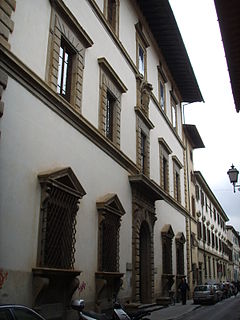
The Palazzo Giugni, also called the Palazzo Firenzuola, is a late-Renaissance or Mannerist architecture palace designed by Bartolomeo Ammanati, and located on Via degli Alfani #48 in the quartiere San Giovanni of Florence, region of Tuscany, Italy. It is located down the street from the Brunelleschi's church of Santa Maria degli Angeli.
The Palazzo Orlandini del Beccuto, also known as Palazzo Gondi di Francia is a palace located with entrance on Via de' Pecori #6-8 in central Florence, region of Tuscany Italy.

The Palazzo Nasi, also known as the Palazzo Torrigiani or Palazzo Scarlatti, is a palace located at Piazza de' Mozzi 4, down the street where the Ponte alle Grazie enters the Oltrarno, in Florence, Tuscany, Italy. Another Palazzo Torrigiani Del Nero, with a Mannerist or late-Renaissance-style facade stands closer to the river. Both palaces also once belonged to the Nasi. The palace is a few steps from the Palazzo Mozzi.
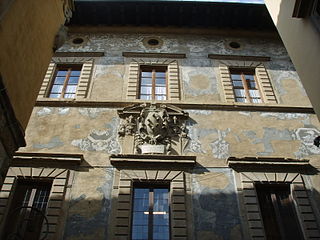
The Palazzo Ramirez de Montalvo, also known as Palazzo Matteucci is a palace located on Borgo degli Albizi #26 in central Florence, region of Tuscany Italy.
The Palazzo Viviani della Robbia is a Baroque-style palace located on Via de Tornabuoni #15, corner with Via della Spada, in the quartieri of Santa Maria Novella, city of Florence, region of Tuscany, Italy.
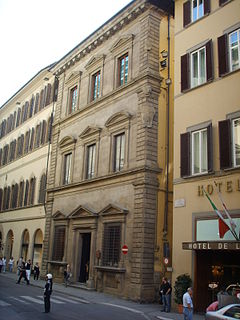
The Palazzo Larderel, once Tebalducci and Giacomini is a Renaissance-style palace, located on Via de' Tornabuoni number 19, corner via de' Giacomini 1, in the city of Florence, region of Tuscany, Italy.
The Palazzo Tempi, also known as Palazzo Vettori or Bargagli Petrucci, is a palace located along the Arno river at the narrow Piazza Santa Maria Soprarno 1, corner with Via de' Bardi and Costa dei Magnoli in the Oltrarno section of Florence, Tuscany, Italy. The palace is across the river from the Galleria of the Uffizi, and a block east of the Ponte Vecchio. The Via de' Bardi originates in an arch under the building.

Museo di Firenze com'era was a history and archaeology museum, one of the civic museums of the city of Florence.



















